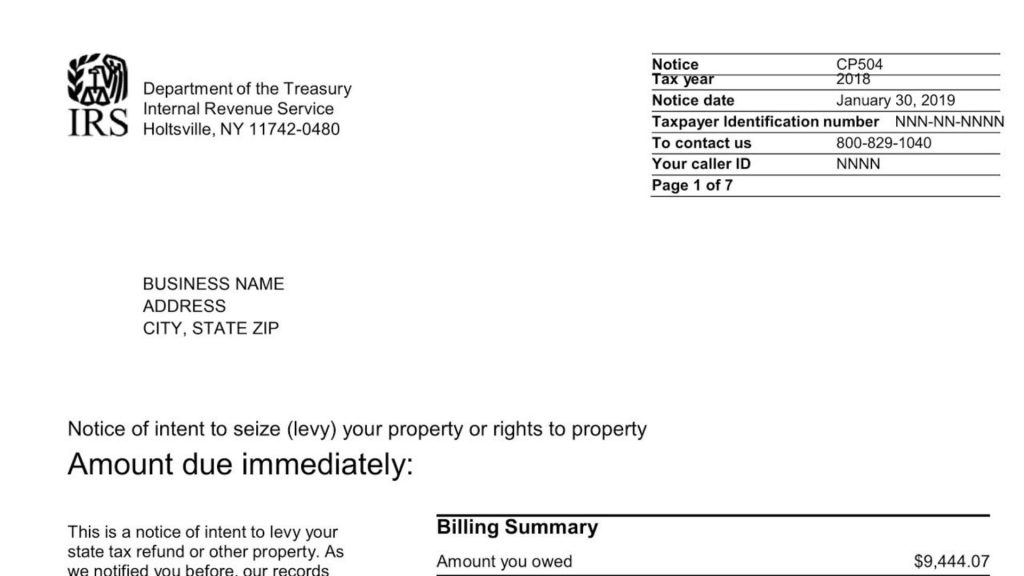
When you Received a Notice of Intent to levy as to accounts, this signals that the IRS is preparing to seize your assets, including your bank accounts, to settle outstanding tax debts. A Notice of Intent to Levy (CP504) is a serious document issued by the IRS as a final warning before they take legal action to collect unpaid taxes. The IRS can legally seize a variety of assets such as wages, bank accounts, state tax refunds, retirement accounts, Social Security benefits, business assets, and even property like cars and homes to satisfy the debt. Typically, the IRS sends multiple notices as a reminder of the outstanding debt and encourages taxpayers to address the issue before resorting to a levy. The IRS Notice, The Notice of Intent to Levy, will include important information such as:
- Taxpayer information (name, address, social security number)
- The amount owed
- The tax period for which the debt is owed
- Payment instructions
- Deadline for action
- Taxpayer rights
- Contact information
What Happens if You Don’t Respond?
Failing to respond appropriately to the Notice of Intent to Levy can have serious consequences. This can include:
- Immediate loss of assets: The IRS can move forward with seizing assets listed in the notice, including funds from your bank accounts.
- Financial disruption: Loss of access to funds and assets can disrupt your daily financial activities.
- Damaged financial reputation: A levy can negatively affect your creditworthiness and financial standing.
- Legal consequences: You could face hefty fines or even criminal charges in some cases.

Immediate Steps After Receiving CP504
1. Review the Notice for Accuracy Carefully examine the notice to ensure all the information is correct. Contact the IRS immediately using the number provided on the notice if you find any discrepancies.
2. Seek Professional Assistance Consulting with a tax professional, such as a tax attorney, is highly recommended, especially if you’re uncertain about how to proceed. They can guide you through the complexities of tax laws, help you understand your rights, and assist with negotiations or appeals.
3. Understand Your Rights The IRS is obligated to inform you of your right to appeal under IRC Section 6330. This allows you to challenge the levy by requesting a Collection Due Process Hearing within a 30-day window of receiving the notice.
4. Explore Resolution Options:
- Immediate Full Payment: The quickest way to resolve the issue is to pay the total outstanding debt immediately, effectively halting further collection actions.
- Installment Agreement: You can negotiate an Installment Agreement (IA) with the IRS to make monthly tax payments. This option helps avoid immediate asset seizure as long as payments are consistently made.
- Offer in Compromise: You can apply to settle the tax debt for a lower amount than what you originally owed through an Offer in Compromise (OIC). However, acceptance of an OIC is not guaranteed and requires demonstrating significant financial hardship.
- Collection Due Process Hearing: As mentioned earlier, this formal appeal process allows you to present your case and explore alternative solutions before the IRS proceeds with the levy.
- CNC Status: If you can prove that paying your tax debt would create severe financial hardship, you may qualify for Currently Not Collectible (CNC) status. This temporarily suspends collection efforts, but the IRS will reassess your financial situation periodically.
FAQs
- What is a Notice of Intent to Levy?
- It’s a final warning from the IRS stating their intent to seize assets to satisfy a tax debt.
- What assets can the IRS levy?
- The IRS can potentially levy a wide range of assets, including bank accounts, wages, property, and retirement funds.
- How much time do I have to respond to the notice?
- You typically have 30 days from the date on the notice to respond or take action.
- What happens if I disagree with the amount owed?
- You have the right to appeal and request a Collection Due Process Hearing.
- Can I avoid a levy altogether?
- Yes, by fully paying the debt, negotiating a payment plan, or exploring other resolution options like an Offer in Compromise or CNC status.
- Should I seek professional help?
- Consulting a tax professional is highly recommended to help you understand your options and rights and guide you through the process.
It’s important to take any communication from the IRS seriously and act promptly to protect your assets and financial well-being. Remember, you have rights as a taxpayer, and various options are available to help you resolve outstanding tax debts and avoid a levy.